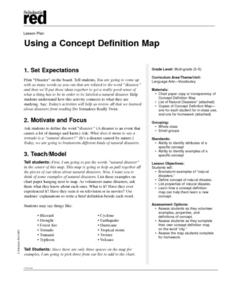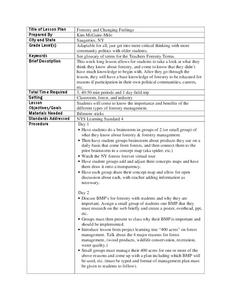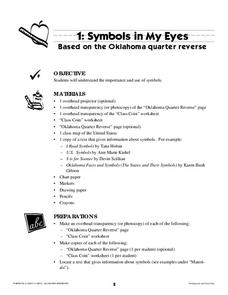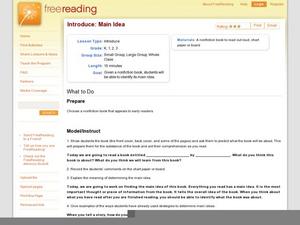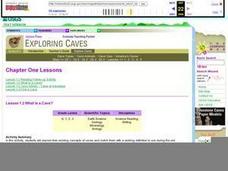Curated OER
Using a Concept Definition Map
Students define "natural disaster" by offering examples and charting them to discover what a concept definition map is. Then students create their own maps using the word "city".
Curated OER
Forestry and Changing Feelings
Students investigate how the forest affects their daily lives by creating a concept map. In this ecological instructional activity, students create a concept map linking the forest to the many things they use each day....
Curated OER
Bringing Household Items to Life
Use folk tales as inspiration for learning about and using personification in creative writing. Learners brainstorm together in order to practice personification before writing their own poems or paragraphs about a household object.
Curated OER
Using Color as a Pre-Writing Tool
To better understand how to compose a clear and well-organized paper, learners read short passages, write summaries, and make colored graphic organizers. This is a fully developed three-day lesson with suggested assessments.
Curated OER
Concept Webs for the Components of a Coastline
Students describe the components of a coastline. In this lesson on coasts, students brainstorm the various features of a coastline.
Curated OER
It's Under Discussion
Students create brainstorming webs to facilitate discussions about writing about an informational topic. In this writing lesson plan, students do this in groups and then free write about their topic.
Curated OER
Appetizing Adverbs
Have your class construct an adverb wheel. Learners brainstorm adverbs to modify the verbs they use to describe how they will eat a doughnut hole. They then use the wheel to help them write creative sentences.
Science Matters
Basic Needs
Scholars take part in a grand conversation about the basic needs of living things. Working collaboratively, pupils brainstorm and identify similarities to come to the conclusion that the environment meets the needs of all living...
Teachers.net
How to Write a Movie Review from a Pet's Perspective
When would two paws up denote a blockbuster film in your classroom? Only when young writers create movie reviews from a pet's perspective in this imaginative expository writing practice. This engaging topic begins with a class discussion...
Curated OER
CAN WE SWITCH GENDERS OF STORY CHARACTERS?
Analyze characters and stories to identify stereotyping. Learners will examine the concept of character gender to evaluate bias in classroom story books. They are asked to read a story or play and change the gender of the character to...
Creative Educator
Dream Room Design
Junior designers brainstorm the elements that a bedroom might have, such as a bed, television, and dresser. They identify which items are needs and which are desires. They practice measurement skills in the classroom by determining its...
Curated OER
Forces of Flight - Lift
Students design and test paper airplanes to understand the concept of lift and how it affects flight. This technology-based Science lesson plan is excellent for use with upper-elementary and middle-level learners and uses spreadsheet...
Curated OER
Social Class Stereotypes
Encourage your students to think about how and why people and categorized in terms of social class. They decide what "class" they belong to, and then brainstorm about the indicators that society uses to define class and to categorize...
Center for Learning in Action
Introduction to Matter
Begin your states of matter lessons with a demonstration designed to introduce the concept that all matter has properties. Reinforce this concept through vocabulary exploration, and the creation of atom models; salt, water, and carbon...
Curated OER
Water Uses and Children's Lives in East Africa
Students explore water usage around the world. In this "water" social studies instructional activity, students brainstorm ways in which water is used. Students visit the Water in Africa website to view pictures of water usage...
US Mint
Symbols in My Eyes
Explore the hidden meanings behind the images on US currency with this elementary school lesson on symbolism. Starting with a class discussion about symbols, children go on to brainstorm different objects that represent the Unites...
Growing Kids Ministry
Useless Junk? or Made with a Purpose?
Demonstrate that all items (and people) have a purpose in God's plan with a Sunday School assignment. After examining seemingly useless items, such as bolts, paper clips, or batteries, kids fill in the blanks to express the item's...
Curated OER
LET'S GET ORGANIZED
Students use organizational skills and involve youth in the planning of their school and home recycling project. They brainstorm to find the most efficient way to set up a recycling collection system
Curated OER
Olympic Engineering
Young scholars explore the concept of problem solving using the Olympics as the topic. In this problem solving lesson, students learn how engineers brainstorm, and come up with design ideas that are difficult to accomplish while trying...
Curated OER
Introduce: Main Idea
Begin exploring main idea in a text by telling the class an interesting story. Can they recall the main idea after you finish? What clues told them this was it? Explain that you will apply this concept as you read a nonfiction book....
Curated OER
Food and Culture: Exploring the Flavors of Your Community
Students brainstorm the types of food they eat at home, discussing and comparing with the class. Students brainstorm and make a chart of questions that came out of the activity and their discussions. Students interview someone who...
Curated OER
Definition Poems
“Hope is a tissue, wiping away your problems and fears.” Use a Definition Poem Web worksheet to model for your class how to craft a free verse poem based on an emotion. After brainstorming topics, groups use the sheet to make comparisons...
Curated OER
Finding Your Way in the World Wide Web
Researchers practice grouping items to explore the concept of a database. They apply these concepts to the WWW search engine format and consider why it is important to enter the most specific information.
Curated OER
What Is A Cave?
Students explore their existing concepts of caves and match them with a working definition to use during the unit. They name the two types of rock formations in which most American caves occur, and define "show cave" and "wild cave."
